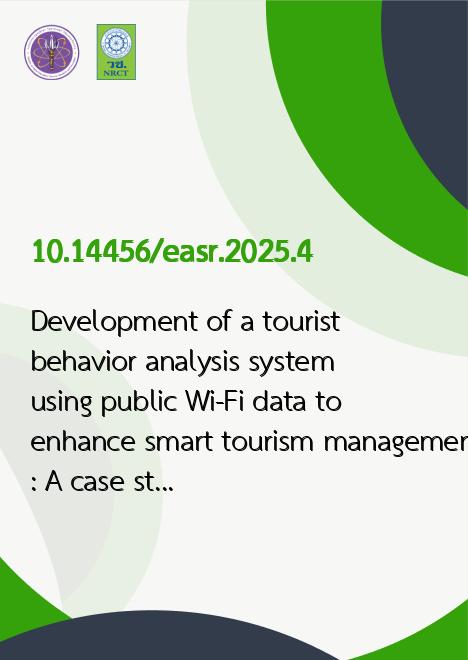
|
Development of a tourist behavior analysis system using public Wi-Fi data to enhance smart tourism management: A case study of Sri Chiang Mai Smart City |
|---|---|
| รหัสดีโอไอ | |
| Creator | 1. Thalerngsak Wiangwiset 2. Chayada Surawanitkun 3. Wullapa Wongsinlatam 4. Tawun Remsungnen 5. Kanda Sorn-in 6. Apirat Siritaratiwat 7. Chavis Srichan 8. Prachya Thepparat 9. Weerasak Bunsuk 10. Aekkaphan Kaewchan 11. Wisut Supasai 12. Ariya Namvong |
| Title | Development of a tourist behavior analysis system using public Wi-Fi data to enhance smart tourism management: A case study of Sri Chiang Mai Smart City |
| Publisher | Faculty of Engineering, Khon Kaen University |
| Publication Year | 2568 |
| Journal Title | Engineering and Applied Science Research |
| Journal Vol. | 52 |
| Journal No. | 1 |
| Page no. | 42-56 |
| Keyword | Smart city, Smart tourism, Tourist behavior, Wi-Fi usage analysis, Spatial and temporal analysis, Resource management |
| URL Website | https://ph01.tci-thaijo.org/index.php/easr/index |
| Website title | Engineering and Applied Science Research |
| ISSN | 2539-6161 |
| Abstract | Sri Chiang Mai Smart City faces challenges in tourism management due to its limited understanding of tourist behavior patterns and inefficient resource management at tourist attractions. The study aims to analyze tourist movement patterns and preferences across key locations, develop a privacy-preserving data collection framework, and provide data-driven recommendations for tourism resource allocation. The system analyzes Wi-Fi data from 11 strategic locations along the Mekong River using spatial and temporal analysis techniques. Tourist data is protected with SHA-256 encryption and tokenization of MAC addresses. Analysis of over 72 million connection records from May 2022 to December 2023 revealed significant patterns in tourist behavior. Tourist numbers showed dramatic increases during cultural events, with a 127.87% increase during the Songkran festival from April 13 to 15 compared to regular days in the same month at Boeng Wiang Courtyard. Four locations consistently showed higher visitor levels: Sri Chiang Mai Community Health Park, Naga Courtyard, In front of Had Pathum Temple, and Boeng Wiang Courtyard. Temporal analysis identified peak hours between 17:00 and 21:00, especially during the Songkran and longboat racing festivals. The findings enabled data-driven decisions in tourism resource allocation, event planning, and infrastructure development. However, the study is limited to tourists who connect to public Wi-Fi, potentially excluding those using mobile data or no digital devices. Despite these limitations, the system demonstrates how smart city infrastructure can effectively support smart tourism management through privacy-preserving data collection and analysis, contributing to the development of sustainable smart tourism initiatives. |
